Take tests it is necessary once every six months or a year - this way you can find out the level of hemoglobin, estimate the number of platelets, leukocytes, erythrocytes. A blood sampling scarifier is used to relieve pain during the test.
Record content:
- 1 What is a scarifier?
- 2 Types of scarifiers
- 3 Main advantages
-
4 How to use it correctly?
- 4.1 Modern scarifiers
- 4.2 Children's scarifiers
- 5 Requirements for scarifiers
- 6 Popular manufacturers and prices
- 7 How to choose and where to buy
- 8 How often to change?
- 9 Disposal features
- 10 Video about scarifiers
What is a scarifier?
Everyone should take care of their own health on their own - take vitamin courses, be observed by a therapist, regularly take at least the simplest tests, such as a general check urine, blood.
Many diseases can be determined even at the stage of their development, if you turn to your doctor in time and take a blood test for laboratory research. Such a procedure is carried out quickly, in private and public medical institutions.
According to the opinion of medical professionals, if a person regularly checks his health by taking tests, then almost all diseases developing in his body are determined in the laboratory. That is, you can start treatment and prevent the development of the disease.
A blood sampling scarifier is a special medical instrument designed to take a sample from a patient's finger using a small incision in the skin.
The tool is a stainless steel plate that ends with a sharp needle. Some types of scarifiers may differ, look more modern. Lancets are especially prominent, designed for taking tests from children.
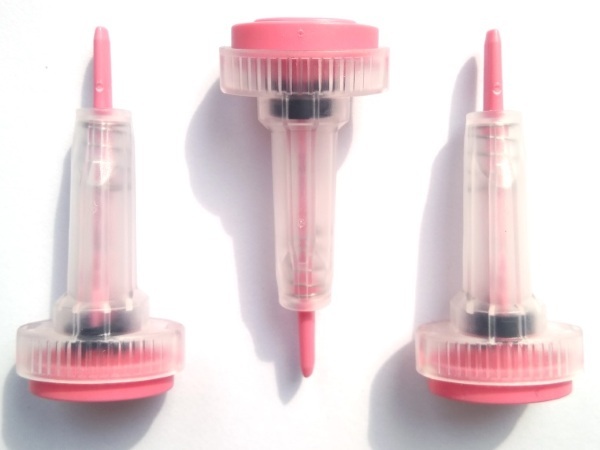
The scarifier is a sterile, sharp spear, usually wrapped in plastic. For the manufacture of equipment, special medical steel is used. Blocking or starting the needle occurs in different ways - it depends on what type of device is used (changes in length, diameter).
To ensure maximum sterility, the equipment is treated with gamma radiation, and then securely packed in containers or sealed with a small lid. A scarifier is a tool that must be properly stored, used and disposed of.
Types of scarifiers
In order to take capillary blood from a finger, various types of equipment are used - scarifiers are made for children and adults and have different lengths and needle thicknesses.
There are such types of medical equipment:
- standard or spear scarifier - ordinary metal plates with a built-in needle in the middle or at the end of the device;
- automatic - the needle is in a special plastic tube and comes out when pressed on the lid;
- baby - thin lancets for painless puncture of the child's toes or heels, do not leave bruises and heal quickly.
Disposable automatic scarifiers are also divided into subspecies.
Based on the purpose of the test, the age of the patient and the condition of the skin, the nurse determines what diameter of the needle would be more correct to use:
- The needle with a diameter of 0.25 mm and a length of 1.2 mm is suitable for children, people with diabetes. Also used for hypersensitivity of the skin or if the skin is too delicate, thin.
- A scarifier with a diameter of 0.5 mm and 1.5 mm in length is used to take a blood test to determine the level of sugar in the body of children and adults.
- A lancet with a length of 1.8 mm and a diameter of 0.8 mm is used to draw large amounts of blood at a time. Typically used for gas or coagulation analyzes.
- In cases where a patient who comes for tests has too rough, thick skin, and it is necessary to take a large amount of blood, then a needle with a diameter of 0.8 mm and a length of 2.4 mm is used.
- Blood for analysis in infants is taken from the heel using a scarifier 0.8 mm in diameter, with a length of 2 mm.
The variety of medical device sizes is due to the large number of manufacturers putting the product on the market. Not only the dimensions of the tool can change, but also the process of starting or blocking the needle.
Main advantages
A blood donor scarifier can be purchased at a pharmacy. Before that, you need to consult with a pharmacist, ask what tool is required for this or that analysis. It is important to understand which device is suitable for rough or too thin skin, exactly how it looks.
For example, if you need to make a puncture for a child, it is better to stop at an automatic device with a bright color, so the child will not experience stress because he will not see the needle.
The main advantages of the scarifier include:
- confidence in the sterility of the instrument, safety in use - having come to take the analysis, the patient can be calm, because he knows that no one has used the purchased device before;
- lack of pain, bruises on the finger, if the scarifier was correctly selected for the type of skin and analysis;
- minimal contact with the environment - the standard plate is unpacked immediately before the injection is made, that is, the ingress of microbes on it is negligible. The risk of catching an infection (viral hepatitis or HIV) is reduced to zero;
- speed and ease of use;
- low cost and availability of the device - can be purchased at any pharmacy;
- lack of moral discomfort when taking the test.
Often, standard scarifiers are replaced with lancets - improved versions that make blood collection painless. This tool is especially popular when working with children.
How to use it correctly?
Laboratory workers and ordinary patients who use scarifiers to measure blood sugar at home need to understand how to use the device correctly.
For proper use, you must adhere to a few simple rules:
- Before use, you must study the instructions for the model, which was purchased from the pharmacy for blood sampling.
- Inspect the packaging - you need to make sure that it is not damaged and remains sealed.
- Next, you need to select the place where the puncture will be made - treat it with an antiseptic to disinfect the skin area and avoid infection.
- Gently puncture and complete blood sampling.
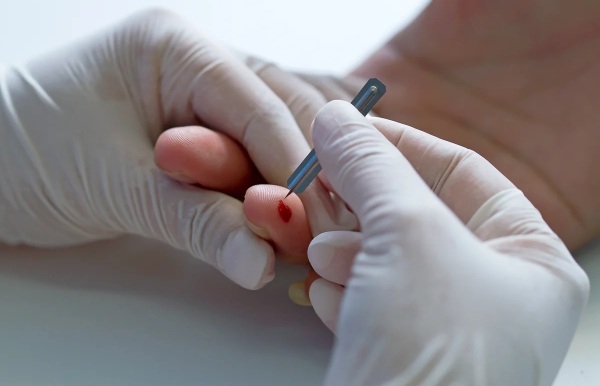
- Apply a cotton swab moistened with an antiseptic agent to the punctured skin area, and dispose of the used scarifier.
These rules apply to all models and varieties of medical fingerstick sampling equipment.
Modern scarifiers
Modern models of scarifiers that can be purchased at any pharmacy are intended for single use. Many manufacturers put a blocker on the needle to warn their customers against trying to reuse the needle. Thus, it becomes impossible to make a second puncture, even if desired.
According to the instructions, you must perform the following actions:
- The first step is to wipe the place of the future puncture with an alcoholic or antiseptic drug.
- Take the lancet out of the package, remove the protective plastic cap from it.
- Press the scarifier to the place where the skin puncture will be made.
- Press on the puncture site with a lancet - a needle will appear from it, which will create a small cut and after that it will automatically be removed inside the plastic case.
- After taking the sample, apply a cotton wool soaked in an antiseptic to the puncture site. The disposable scarifier must be processed and disposed of.
This equipment can be used to obtain capillary blood from the earlobe, the pad of the toe or the heel - these are ideal places for taking a test.
Children's scarifiers
The scarifier that will be used to draw blood from a child must be carefully selected so that the baby does not feel unnecessary stress and does not complicate the procedure.
Automatic lancets are perfect for children of different ages - the needle is not visible and the moment of skin puncture is almost not felt due to the fact that the plastic tube is firmly pressed against the finger. Also, the wound that arose after the analysis quickly tightens and does not cause discomfort.
The analysis algorithm is as follows:
- The site of the future injection is wiped with an antiseptic solution.
- The scarifier is taken out of the package, the cap is removed from it, which protects against germs from entering the needle.
- The device is applied to the place where the blood will be drawn - it must be pressed firmly.
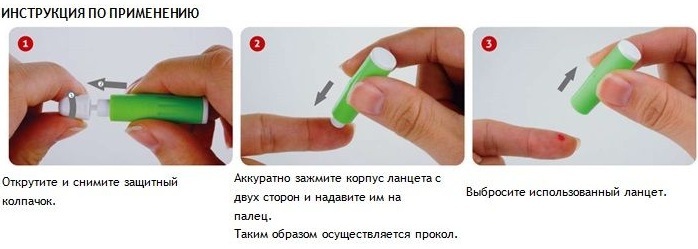
- If an automatic model is used, then you only need to apply light pressure, otherwise you will have to make an incision yourself.
- A cotton swab with an antiseptic solution is applied to the wound, and the lancet is disposed of.
Scarifiers with thin needles are usually used; their properties do not differ from the simplest, standard devices.
Requirements for scarifiers
It is necessary to approach the choice of a scarifier carefully, otherwise it may not be possible to carry out the analysis calmly - the needle will not enter the skin or several cuts will have to be made. It is important to take into account the type of patient's skin, as it will be painful for those who are too thin to use a wide device and vice versa - a thin needle will not be able to pierce rough skin.
The main requirement for any type of scarifier is its sterility.
Make sure that:
- the packaging has not been damaged;
- the protective cap tightly covers the needle;
- unpacking occurs immediately before the injection;
Only under such conditions is it allowed to take capillary blood for analysis. These precautions help preserve the patient's health and reduce the likelihood of infection.
Popular manufacturers and prices
Many companies are developing more and more every day, releasing more and more new drugs and medical equipment - improving their functions, making it easier to use.
Scarifier for blood sampling can be found in many pharmacies and get confused when buying from a variety of devices and their manufacturers.
Common and current models include:
| Model | Description |
| Lancets Medlance Plus | The tools produced by the Polish company are sold in 4 types. For adults, blue scarifiers with a 1.8 or 2.4 mm needle are offered, and for children, purple scarifiers with a 1.5 mm needle are available. There is also a lancet with a 2 mm blade. The cost of 1 package ranges from 1,800 to 2,400, the price of one is 10 rubles.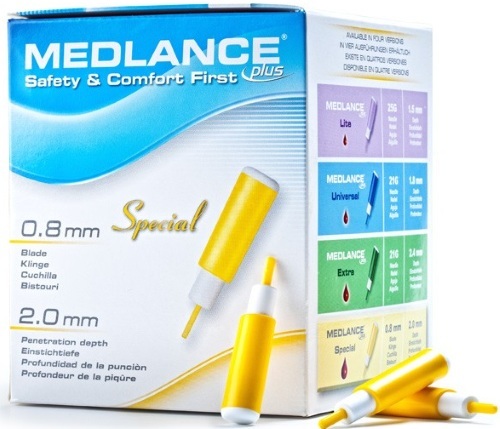
|
| Scarifiers Prolance | There are six main types of tools, they differ in the sizes of needles and blades (from 1 to 1.8 mm), each size is marked with a specific color. The cost of 1 package on average reaches 1800 rubles. |
| Bd Microtainer Automatic Instruments | 2 main types with a needle, lilac and pink, 1.5 and 1.8 mm each, respectively. Blue scarifiers are sold with a 2 mm blade. Packing price 2900-3200 rubles. |
| Lancets Acti-Lance | Product from a Polish company, recommended for children and adults with delicate skin. Available in purple and blue scarifiers with 1.5 and 1.8 mm needles. You can choose a 2mm blade in yellow. On average, the cost of a box reaches 1800 rubles.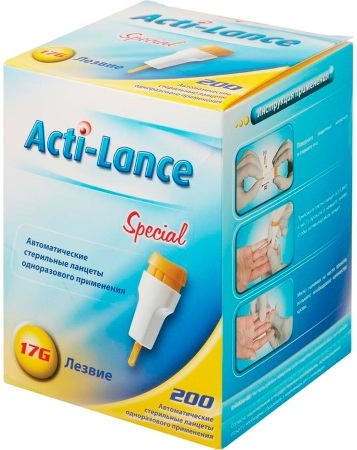
|
| Tools from MiniCollect | Available in a large assortment, you can choose a needle for any analysis and skin type. There are three types of blades (from 1 to 2 mm) and two versions of 1.25 mm needles with different puncture depths. A box of scarifiers costs 3300 rubles. |
Each package contains 200 lancets, most types are sold individually for one test. If needles are required to measure and control blood sugar levels, it is more economical to buy a whole box. Prices also differ on whether standard blades or automatic blades are chosen (pack of 200 pcs. universal needles costs about 600 rubles).
How to choose and where to buy
Before buying a scarifier, you need to check with your doctor what tests will be taken, because the diameter of the needle required for puncture will depend on them.
You also need to decide whether to buy a standard blade or an automatic one, which, judging by the reviews, is considered less painful and does not leave significant marks. When buying, you need to focus on the color of the box, because it is he who is responsible for the size of the needle.
You can buy a scarifier at any pharmacy, and they can also be offered when taking an analysis at a polyclinic. When buying, it is important to look at the expiration date and the integrity of the product packaging.
How often to change?
Patients with diabetes mellitus or people who are going to take various tests need to remember one important rule.
The Blood Collection Scarifier is a disposable instrument that must be disposed of after one use.
There are a number of reasons why the needle is only allowed once:
- microbes may remain on the needle, that is, the risk of various infections entering the blood increases;
- scarifiers with an automatic mechanism are equipped with a lock, which does not allow reusing the consumable;
- if you use the same needle several times, then the blade becomes dull, which means that severe pain appears due to the inability to make a quick puncture;
- the presence of other microorganisms on the tip can affect not only the increase in the likelihood of infection, but also change the accuracy of the indicators.
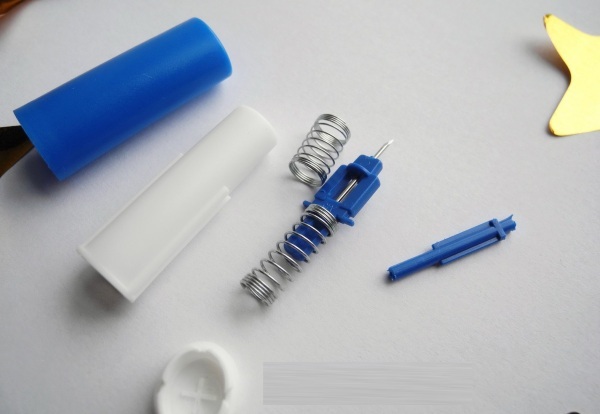
This rule applies to all types of lancets and needles for glucometers sold in pharmacies and used in hospitals.
Disposal features
Used scarifiers are classified as level B medical waste, that is, it is not allowed to simply throw them into the trash can. This is especially true of needles left over from patients who are infected with an infectious disease.
Before you dispose of the device, you must decontaminate it - using 1 of 2 methods. The 1st is the sterilization of the needle, and the 2nd is the heat treatment of the device. After that, the disposable lancet can be safely thrown into the general trash, it is considered a safe waste.
Convenient blood sampling is carried out using a scarifier - a small plate with a needle or blade at the end or on the side. Often, taking an analysis from a finger, earlobe or heel can cause discomfort in the patient, physical and mental discomfort - this applies to both adults and children.
Modern lancets, used in the laboratory or at home, are designed to facilitate the entire process - there is no pain, bruising or other visible damage.
A small wound after an injection heals quickly, and children, due to the fact that they do not see the needle, behave calmly. Universal and automatic models can be bought at pharmacies, but it is important to understand the color coding in order not to make the wrong choice.
Article design: Vladimir the Great
Video about scarifiers
About scarifiers for blood sampling:

